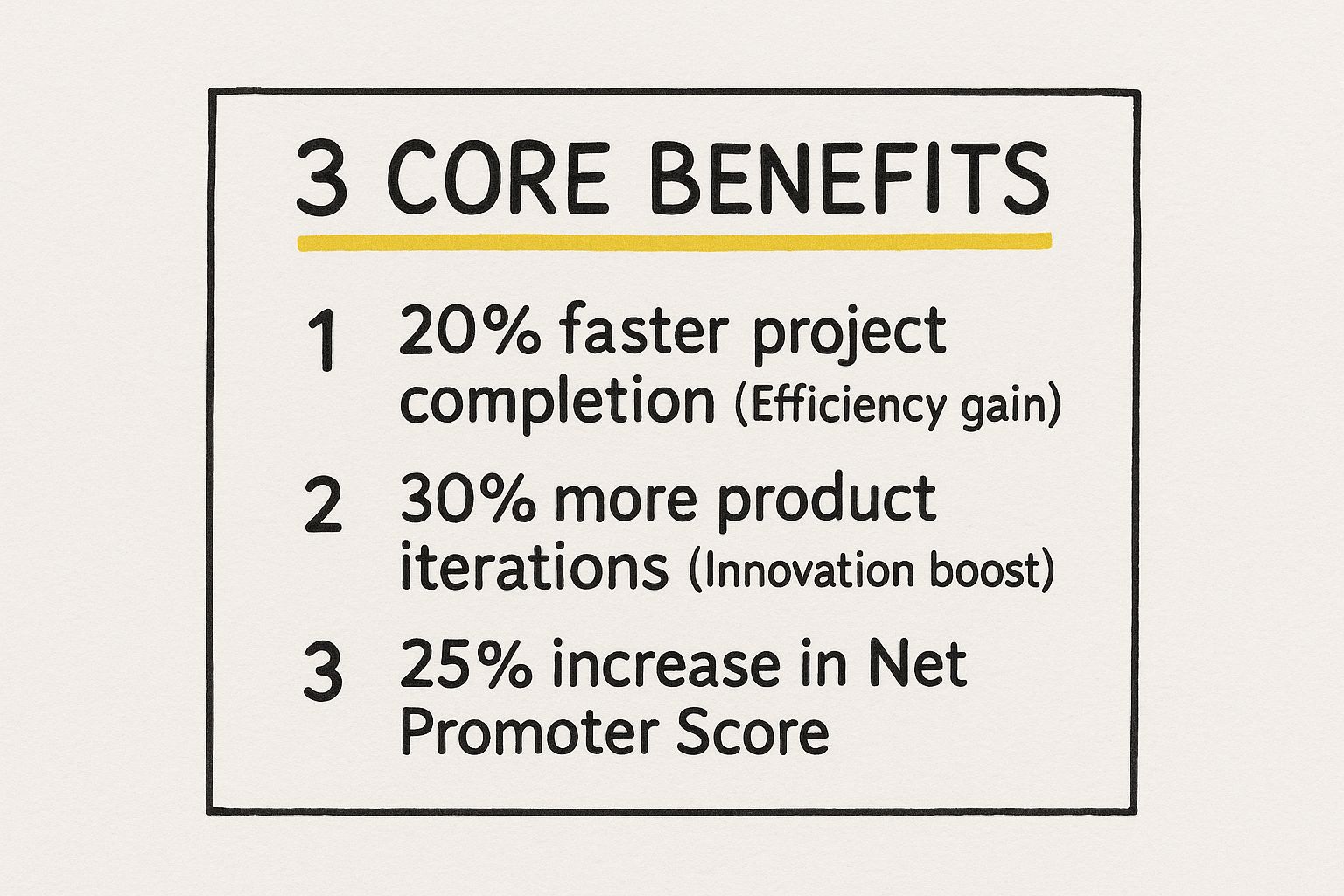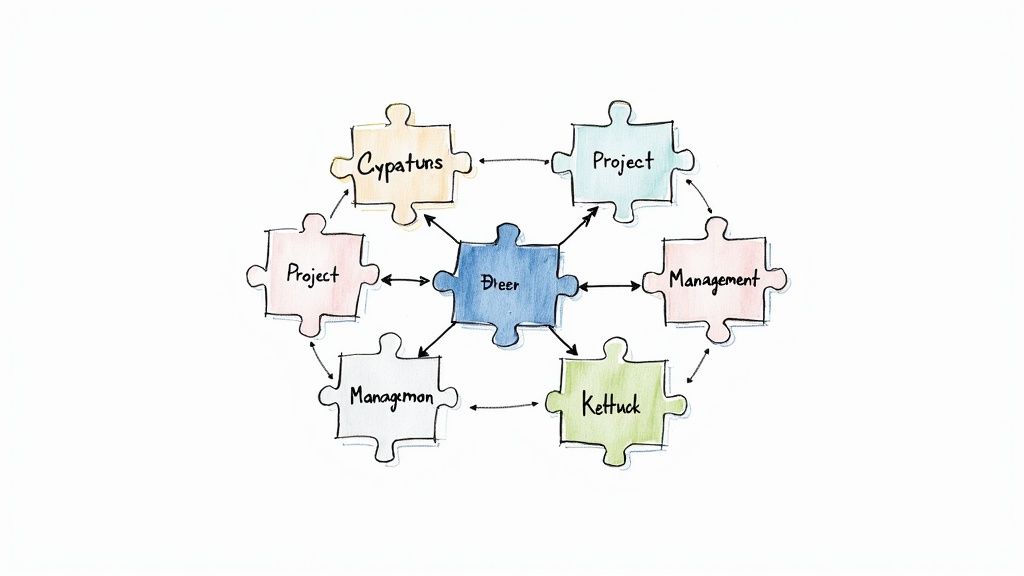October 16, 2025

Think of a business where every department operates on its own little island. Marketing has its goals, sales has theirs, and the product team is off building something else entirely. They might occasionally send a message in a bottle to another island, but for the most part, they’re working in isolation. This is what we call working in silos, and it’s a recipe for disjointed efforts and missed opportunities.
Cross-departmental collaboration is the bridge that connects those islands. It’s when those distinct teams—marketing, sales, product, customer support—actively work together on a shared project or a common goal, pooling their unique skills and perspectives to create something better than any single team could alone.

Let’s move beyond the jargon. A great way to picture this is to think of a symphony orchestra. Each section—the strings, the brass, the percussion—is filled with expert musicians. If they all played their own tune without listening to each other, the result would be chaos. It’s just noise.
But when they follow the same conductor and the same sheet of music, something magical happens. They align their timing, blend their sounds, and create a powerful, cohesive masterpiece. That’s what true cross-departmental collaboration looks like in a company. Teams aren’t just talking to each other; they are intentionally weaving their work together to achieve a shared objective.
It's easy to mistake simple cooperation for true collaboration, but they are worlds apart. Cooperation is more passive—it's essentially "I'll do my part if you do yours." Collaboration, on the other hand, is an active, dynamic process of creating something together.
It requires a few key ingredients:
This deeper level of integration is what separates good companies from great ones. Before diving deeper, it's worth taking a moment for understanding what team collaboration means in a general sense, as it lays the groundwork for everything else.
Working in silos isn't just inefficient; it's actively harmful. When teams hoard information or become territorial, innovation grinds to a halt. You see it all the time: marketing promotes a feature that engineering hasn’t finished, or the sales team promises a solution that customer support has no idea how to service.
This kind of disconnect burns through resources, creates immense frustration for employees, and ultimately leads to a terrible customer experience.
Breaking down these walls is non-negotiable. Effective cross-departmental collaboration gets everyone rowing in the same direction, guided by a clear, unified vision. The linchpin holding all of this together is solid communication. For more on that, check out our guide on how to improve team communication. Getting this right is the first step toward building a truly connected and high-performing organization.
So, what happens when you actually get this right? When teams stop guarding their territory and start sharing their expertise, the whole company wins. The benefits aren't just small, isolated improvements; they snowball, creating a powerful compounding effect that touches every part of the business.
This synergy doesn't just feel better—it boosts performance, drives growth, and builds a more resilient and competitive company from the inside out.
One of the first things you'll notice when silos come down is a huge jump in efficiency. Redundant tasks disappear, handoffs between teams become seamless, and problems get solved in a fraction of the time. Think about it: when Sales gives Marketing direct feedback on lead quality, Marketing can tweak its campaigns on the fly instead of wasting time and money on strategies that just aren't working.
This kind of alignment hits the bottom line, hard. Research shows that companies with strong cross-functional teamwork are 21% more likely to be more profitable than their competitors. They can also slash project cycle times by up to 30%, which means getting products to market faster and reacting to new opportunities before anyone else. If you want to dig deeper into the numbers, you can learn how to apply these findings to your business.
This infographic gives a quick snapshot of the key metrics that get a lift from genuine teamwork.

As you can see, these aren't just fuzzy concepts. They translate into real, measurable gains in speed, innovation, and how much your customers love you.
Real innovation almost never happens in a vacuum. The best ideas—the truly game-changing ones—spark at the intersection of different viewpoints and skills. When your engineering, product, and marketing folks are in the same room from day one, they can build something that's not only technically brilliant but also perfectly in tune with what the market actually wants.
Picture an engineering team with a direct line to customer support. What happens?
This collaborative loop ensures innovation isn't just about building new things; it's about building the right things. It’s about creating solutions that genuinely make customers' lives easier.
Instead of working off assumptions, teams can make smart decisions based on a complete picture of the customer. This means fewer wasted development cycles and a product that constantly gets better in ways that matter.
At the end of the day, every single department—from accounting to engineering—works for one person: the customer. But when teams are walled off from each other, that customer's experience becomes disjointed and frustrating. The promises Sales made don't quite match what the Product team delivered, and the support they get feels completely disconnected from the brand's marketing.
True cross-departmental collaboration is what stitches that journey together into a single, seamless experience.
When Sales, Marketing, and Customer Success are all on the same page, they present a unified front. Marketing brings in great leads that Sales can actually close because the message is consistent. Then, post-sale, the Success team is ready to onboard that new client perfectly because they know exactly what was promised. This cohesive approach has been shown to improve customer satisfaction scores by about 20%, building the kind of loyalty that turns happy customers into your biggest fans.

While everyone agrees that cross-departmental collaboration is a good idea, making it happen is another story entirely. It's a classic case of "easier said than done." Even companies with the best intentions find their collaboration initiatives hitting a wall. But this friction isn't a sign that the effort is doomed; it just means you've run into predictable—and solvable—roadblocks.
The truth is, building a truly connected workplace is a journey, and like any journey, it has its challenges. A widely cited study from Harvard Business Review found that a staggering 75% of cross-functional teams are actually dysfunctional. That number tells a crucial story: effective collaboration doesn't happen by accident. It requires a deliberate strategy.
To get there, you first have to know what you're up against. Successfully navigating this path means spotting these common hurdles early and putting the right solutions in place to dismantle them.
Before you can treat the illness, you have to recognize the symptoms. Organizations suffering from "silo sickness" have a distinct and frustrating feel—think friction, finger-pointing, and a constant sense of missed opportunities. In contrast, truly collaborative workplaces are defined by alignment, shared ownership, and proactive problem-solving.
So, how does your company measure up? This table is a quick diagnostic tool to help you see where your teams fall on the spectrum.
By comparing these behaviors, you can start to pinpoint exactly what's holding your teams back and get to the root of the problem.
One of the most common and destructive roadblocks is when departments have goals that are fundamentally at odds with each other.
Picture this: your Sales team is bonused on closing deals quickly, so they promise customers a bunch of new features. At the same time, the Engineering team's main objective is maintaining system stability, which requires them to slow down and carefully test any new releases. This setup creates a natural, constant state of conflict.
The only way out of this trap is to establish a higher-level set of shared goals that forces everyone to pull in the same direction.
When everyone is measured by the same ultimate outcome, internal competition starts to fade, and genuine partnership takes its place.
"True collaboration happens not when departments simply talk to each other, but when they are judged by the same scoreboard. Shared goals are the ultimate silo-busters."
Another huge problem is a fractured tech stack and communication process. When Marketing is on Slack, Engineering lives in Jira, and Sales communicates everything over email, critical information inevitably gets lost in translation. This isn't just inefficient; it breeds frustration, mistrust, and misunderstanding.
Centralizing communication is absolutely essential. This doesn't mean forcing every team onto a single tool for every task. It means creating a "single source of truth"—a central hub where project updates, documentation, and key decisions are accessible to everyone involved, regardless of their department.
At the end of the day, communication is the lifeblood of collaboration. For practical ways to improve how your teams connect, check out our guide to internal communication best practices. By setting clear ground rules and using integrated tools, you can build the connective tissue your organization needs to thrive.
Knowing you need to improve cross-departmental collaboration is one thing. Actually doing it is a whole different ball game. Without some kind of structure, even the best intentions can dissolve into a mess of endless meetings and zero progress. The trick is to lean on proven frameworks that give your teams a playbook for working together.
Think of these frameworks less as rigid rules and more as adaptable blueprints for a more connected workplace. They provide a common language, clear processes, and defined roles that cut through the confusion. This frees up your teams to focus on the actual work, not get bogged down in figuring out how to work together.
Agile got its start in the software world, but its core ideas are pure gold for any team trying to improve how they work. Two of the most popular flavors of Agile you can steal for your own teams are Scrum and Kanban.
Scrum is fantastic for complex projects with a clear finish line. It breaks work into short cycles called "sprints," usually lasting about two weeks. A team with members from different departments tackles a small batch of top-priority tasks, checks in daily to stay on the same page, and shows off what they've built at the end. This rhythm forces constant communication and keeps everyone moving in the same direction.
Kanban, on the other hand, is all about visualizing your workflow. You use a board (it can be a physical whiteboard or a digital tool like Trello) with columns for each stage of your process—think "To Do," "In Progress," and "Done." This simple visual makes it instantly obvious where work is piling up, helping teams from marketing to HR manage their flow and see where they can jump in to help each other out.
One of the fastest ways to derail a cross-departmental project is confusion over who owns what. When roles are fuzzy, things get missed, decisions get stuck in limbo, and people get frustrated. The RACI matrix is a brilliantly simple tool to head off that chaos before it starts.
RACI is just an acronym that assigns four clear roles for any task in a project:
By hammering out a RACI chart before a project kicks off, you take all the guesswork out of the equation. Everyone knows exactly what's expected of them, which is the bedrock of smooth cross-departmental collaboration.
For a new product launch, for example, the Product Manager might be Accountable. The copywriter is Responsible for the website text, the Legal team is Consulted on the fine print, and the entire Sales team is Informed about the launch date. Simple, right?
As a company grows, expertise tends to get locked away inside departments. A marketer becomes a wizard at SEO, or someone in HR masters a new performance review system, but that knowledge rarely spreads. A Center of Excellence (CoE) is a formal way to bust that expertise out of its silo and share it with everyone.
Essentially, a CoE is a team of designated experts in a specific field. Their job isn’t just to do their own tasks but to develop best practices, create training, and serve as advisors for the rest of the company.
Imagine a Data Analytics CoE that helps sales, marketing, and product teams make smarter, data-backed decisions. This structure doesn't just share information; it actively raises the skill level across the entire organization. It turns isolated pockets of genius into a shared company asset, ensuring everyone is working from the same playbook.
In today's world of remote and hybrid work, technology is the connective tissue for any real cross-departmental collaboration. Picking the right tools isn't just an IT checklist item anymore; it's a strategic decision that fundamentally shapes how your teams talk, share ideas, and move projects from A to Z.
But this isn’t a license to chase every shiny new app. The real art is in building an integrated digital toolkit that actually helps people, rather than overwhelming them with a dozen different logins. A good digital environment is built with intention, specifically to avoid "tool fatigue"—that frustrating state where having too many platforms actually hurts productivity. The goal is a seamless digital workspace where information flows naturally.
A solid tech stack for collaboration usually stands on three main pillars. Think of them as the essential infrastructure for your digital headquarters. Each serves a unique role, but their real power comes from how well they work together.
Communication Hubs: This is your virtual water cooler, conference room, and hallway all rolled into one. Tools like Slack or Microsoft Teams are the command center for real-time conversations and quick check-ins. They pull discussions out of messy email threads and into organized channels, keeping everything focused and transparent. If you're shopping around, exploring a good Slack alternative can help you find features that truly match your company's vibe.
Project and Task Management Platforms: This is where ideas become action items. Platforms like Asana, Jira, or Trello give everyone a bird's-eye view of who's doing what by when. When a project handoff happens between marketing and sales, these tools ensure nothing falls through the cracks. That kind of visibility is absolutely critical for keeping cross-functional work on track.
Centralized Knowledge Bases: This is your company's shared brain. Tools like Notion, Confluence, or the content features within GroupOS itself act as a single source of truth. Instead of critical information getting buried in someone's inbox or lost on a local drive, a knowledge base makes everything—from standard operating procedures to project briefs—available to anyone, anytime.
For instance, the GroupOS platform is built to combine communication and knowledge-sharing into one cohesive experience for your members.

As you can see here, a unified platform can bring different community functions, like events and member directories, together under one roof, making collaboration much simpler.
It's easy to get caught up in the features, but it's vital to remember that software is just a tool. It’s not a magic wand. You can have the most expensive tech stack on the market, but if your company culture doesn't actually value open communication and shared ownership, those tools will just sit there collecting digital dust. The most successful rollouts happen when technology and culture move forward together.
This means training people properly, being crystal clear about how each tool is supposed to be used, and getting genuine buy-in from leadership. Digital tools have forever changed how we work together, but this easy access to information can also lead to overload and blur the lines of work-life balance. For a deeper dive, a 2021 CIPD report explores the complexities of digital collaboration and its effects on organizations.
The ultimate goal is to make collaboration the path of least resistance. When your tools are intuitive and your processes are clear, working together across departments becomes the natural, easy way to get things done.
Frameworks and theories are great, but the real magic happens when you see cross-departmental collaboration work in the wild. The most innovative companies on the planet didn't stumble into success. They figured out how to get different teams, with different mindsets, all rowing in the same direction toward a shared goal.
Take Apple's 'Project Purple,' the secret mission that ultimately gave us the iPhone. It was an absolutely massive undertaking, demanding an intense partnership between hardware engineers, software developers, and industrial designers. They all had to work together under extreme pressure and a thick veil of secrecy.
While the project was full of missteps and crossed wires, it succeeded because of a culture built on radical candor and an unwavering focus on the final product. That single-minded vision paid off, eventually accounting for over 52% of Apple’s revenue.
This high-stakes environment proves a critical point: when the vision is compelling enough, and the right structures are in place, teams can overcome immense friction to create something revolutionary.
Salesforce is another fantastic example, but their approach is less about a single, monumental project and more about embedding collaboration into their daily operations. Their success is driven by a tight, continuous loop between their product, sales, and customer success teams.
It’s a masterclass in synergy:
This creates a powerful flywheel where each team's work makes the others stronger. Building these kinds of internal partnerships, especially between the teams that drive revenue, is a game-changer. For a closer look at how this plays out, think about the crucial goal of achieving sales and marketing alignment.
From Apple’s intense, project-based focus to Salesforce’s model of constant operational excellence, it’s clear there’s no single “right” way to collaborate. It’s all about finding the model that fits your company’s goals. Often, this means creating dedicated groups to lead the charge, much like you'd see in well-organized community of practice examples.
Jumping into a new way of working is bound to bring up a few questions. Let's tackle some of the most common ones that leaders ask when they start building bridges between their teams.
This is a big one. The secret isn't more meetings; it's smarter meetings. You need a clear line between what requires a live conversation and what can be handled on your own time.
Think of it this way: your team's synchronous time—when you're all together—is precious. Guard it fiercely. Use it for the heavy lifting: brainstorming, complex problem-solving, and making critical decisions. For everything else, like routine status updates, shift to asynchronous tools. A quick update in a shared channel or a comment on a project board keeps everyone in the loop without derailing their focus.
Make sure every meeting has a purpose and a clear agenda. And empower your people to decline invitations if the meeting doesn't have a clear goal that requires their input.
If your company culture feels more like a collection of separate islands than a unified team, don't try to boil the ocean. A massive, company-wide overhaul is likely to fail.
The best first step is to launch a high-impact pilot project. Pick a project that's important to the business but small enough to manage, requiring just two or three departments to work together. This could be a new feature that needs input from engineering and marketing, or a customer retention campaign involving sales and support.
Think of this pilot as your test kitchen. You can experiment with new ways of communicating, set shared project goals, and try out collaborative tools in a low-risk environment. When it succeeds, it becomes your best internal case study—the proof you need to inspire bigger changes.
Measuring the return on investment (ROI) for something like cross-departmental collaboration isn't just about one number. It requires looking at both hard data and the softer, more human-centric metrics.
For the quantitative side, you can track concrete business outcomes:
But don't stop there. The numbers only tell half the story. Use simple surveys to gather qualitative feedback. Ask your teams if they feel communication has improved or if there's more trust between departments. By combining these hard metrics with real human insights, you can paint a complete picture of the value you're creating.
Ready to build a truly connected and collaborative community? GroupOS provides the all-in-one platform to centralize communication, share knowledge, and manage events seamlessly. Start your free trial today.


